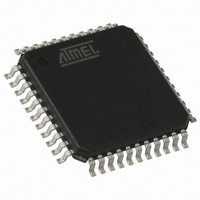AT89C51RE2-RLTUM Atmel, AT89C51RE2-RLTUM Datasheet - Page 134

AT89C51RE2-RLTUM
Manufacturer Part Number
AT89C51RE2-RLTUM
Description
MCU 8051 128K FLASH 44-VQFP
Manufacturer
Atmel
Series
89Cr
Datasheet
1.AT89C51RE2-SLSUM.pdf
(187 pages)
Specifications of AT89C51RE2-RLTUM
Core Processor
8051
Core Size
8-Bit
Speed
60MHz
Connectivity
I²C, SPI, UART/USART
Peripherals
POR, PWM, WDT
Number Of I /o
34
Program Memory Size
128KB (128K x 8)
Program Memory Type
FLASH
Ram Size
8K x 8
Voltage - Supply (vcc/vdd)
2.7 V ~ 5.5 V
Oscillator Type
External
Operating Temperature
-40°C ~ 85°C
Package / Case
44-TQFP, 44-VQFP
Processor Series
AT89x
Core
8051
Data Bus Width
8 bit
Data Ram Size
8 KB
Interface Type
UART, SPI
Maximum Clock Frequency
60 MHz
Number Of Programmable I/os
34
Number Of Timers
3
Operating Supply Voltage
2.7 V to 5.5 V
Maximum Operating Temperature
+ 85 C
Mounting Style
SMD/SMT
3rd Party Development Tools
PK51, CA51, A51, ULINK2
Development Tools By Supplier
AT89OCD-01
Minimum Operating Temperature
- 40 C
Height
1.45 mm
Length
10.1 mm
Supply Voltage (max)
5.5 V
Supply Voltage (min)
2.7 V
Width
10.1 mm
For Use With
AT89STK-11 - KIT STARTER FOR AT89C51RX2
Lead Free Status / RoHS Status
Lead free / RoHS Compliant
Eeprom Size
-
Data Converters
-
Lead Free Status / Rohs Status
Details
Available stocks
Company
Part Number
Manufacturer
Quantity
Price
Company:
Part Number:
AT89C51RE2-RLTUM
Manufacturer:
MSC
Quantity:
1 560
Master Transmitter Mode
Master Receiver Mode
134
AT89C51RE2
W: Write bit (low level at SDA)
A: Acknowledge bit (low level at SDA)
A: Not acknowledge bit (high level at SDA)
Data: 8-bit data byte
P : STOP condition
In Figure 52 to Figure 55, circles are used to indicate when the serial interrupt flag is set.
The numbers in the circles show the status code held in SSCS. At these points, a ser-
vice routine must be executed to continue or complete the serial transfer. These service
routines are not critical since the serial transfer is suspended until the serial interrupt
flag is cleared by software.
When the serial interrupt routine is entered, the status code in SSCS is used to branch
to the appropriate service routine. For each status code, the required software action
and details of the following serial transfer are given in Table to Table 106.
In the master transmitter mode, a number of data bytes are transmitted to a slave
receiver (Figure 52). Before the master transmitter mode can be entered, SSCON must
be initialised as follows:
Table 98. SSCON Initialization
CR0, CR1 and CR2 define the internal serial bit rate if external bit rate generator is not
used. SSIE must be set to enable TWI. STA, STO and SI must be cleared.
The master transmitter mode may now be entered by setting the STA bit. The 2-wire
logic will now test the 2-wire bus and generate a START condition as soon as the bus
becomes free. When a START condition is transmitted, the serial interrupt flag (SI bit in
SSCON) is set, and the status code in SSCS will be 08h. This status must be used to
vector to an interrupt routine that loads SSDAT with the slave address and the data
direction bit (SLA+W).
When the slave address and the direction bit have been transmitted and an acknowl-
edgement bit has been received, SI is set again and a number of status code in SSCS
are possible. There are 18h, 20h or 38h for the master mode and also 68h, 78h or B0h if
the slave mode was enabled (AA=logic 1). The appropriate action to be taken for each
of these status code is detailed in Table . This scheme is repeated until a STOP condi-
tion is transmitted.
SSIE, CR2, CR1 and CR0 are not affected by the serial transfer and are referred to
Table 7 to Table 11. After a repeated START condition (state 10h) the TWI module may
switch to the master receiver mode by loading SSDAT with SLA+R.
In the master receiver mode, a number of data bytes are received from a slave transmit-
ter (Figure 53). The transfer is initialized as in the master transmitter mode. When the
START condition has been transmitted, the interrupt routine must load SSDAT with the
7-bit slave address and the data direction bit (SLA+R). The serial interrupt flag SI must
then be cleared before the serial transfer can continue.
bit rate
CR2
SSIE
1
STA
0
STO
0
SI
0
AA
X
bit rate
CR1
7663D–8051–10/08
bit rate
CR0
















